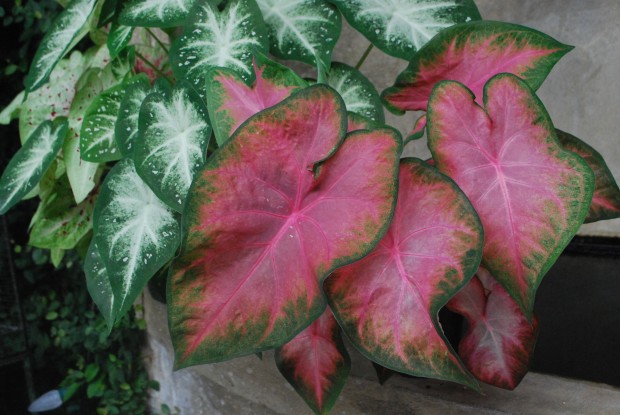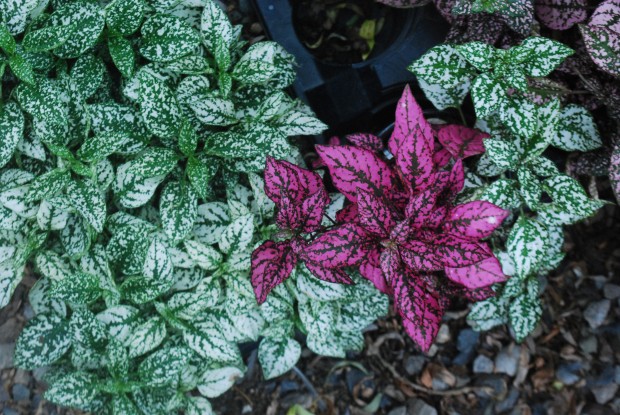Just like you, I understand that the green color of leaves has everything to do with the presence of chlorophyll. There are those dark green leaves. There are those lime green leaves. I want to say the amount of chlorophyll governs the appearance of that green, but I may be making that up. Some plants have leaves with color other than green. This Florida Sweetheart caladium-the leaves are shockingly pink. A clear pink. The color possibilities that this plant enables in a shady spot are many.

I am both surprised and not surprised that I do not see more gardeners using them for seasonal color. I do have clients that insist they want flowers, not colorful leaves. I have no answer to that-it is a matter of taste. But from a design perspective, caladiums provide an opportunity for a big splash of color that is constant throughout the summer season. I suspect another reason why I do not see them much is that they require a lot of heat to grow well. This means that gardeners in my zone who plant in mid or late May may not see caladiums available for sale. My grower’s caladiums are just getting good-this third week of June.

Caladiums are incredibly tolerant of shade. If impatiens or wax begonias make you want to yawn, caladiums are refreshingly different, and quite splashy. 4 plants in one of my deck boxes last summer were the size of a small shrub by summer’s end. A 4th of July trip to see a friend in Kalamazoo last year included a trip to a greenhouse. I bought a suburban load of caladiums, most of which were varieties I had never seen. I did persuade my grower to try some this year-they are just now coming into their own.

Any client who tells me they need white flowers, as opposed to the color white might tempt me to call school into session. White is white-no matter whether than color is represented by wax begonias, non stop begonias, angelonia, cosmos, cleome, dahlias, -or white leaved caladiums. Amazingly, I saw 4 giant planters full of this all white caladium-in full sun, on a city plaza. There was not so much as a single scorch mark. I have not had the nerve to try this at home, as many plants lacking chlorophyll will burn if exposed to too much direct light.
I realize that almost all of the seasonal plants that are available for me to plant are tropical, as in native to tropical locales. But some remind me of of their exotic origins more than others. I have clients for whom I plant bananas, alocasias and calocasias, though I would not want them in my own garden. They seem so blatantly out of place in my Michigan garden. But caladiums are more subtly splashly, given their smaller mature size.
They have a cool, watery, and juicy look. As they thrive in the heat, they always look fresh. If they get too dry, they protest dramatically by falling over. I like plants that do not make a mystery of what it is they need to be happy.
Caladium leaves are medium to large, and beautifully shaped. It seems to me that so many more cultivars are available now than what used to be. But should caladiums simply not appeal to you, there are other seasonal plants with colorful leaves from which to choose.
The polka dot plants-there are those green and white cultivars. There is a pale pink, and a hot pink. The plants are fairly short-they may grow to 12 or 15 inches tall. They respond well to pinching.
There are many varieties of coleus. I am especially fond of those whose leaves feature bright and clear color.
This subtly colored olive and dark carmine variety whose name I do not know is what I cal a chamaeleon plant. Its coloration changes in appearance depending on its neighbor.
Coleus Chocolate mint is aptly named. It is great looking with just about every other color.
This multi colored variety I hear tell wants full sun. When I run into a plant that I am not familiar with, I like to try it at the shop or at home before I plant it for someone else.
We’ll see how it works out-bullseye geraniums, and this fingerling coleus.
























